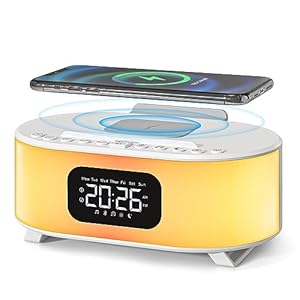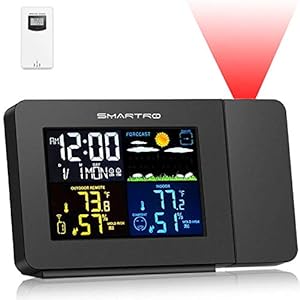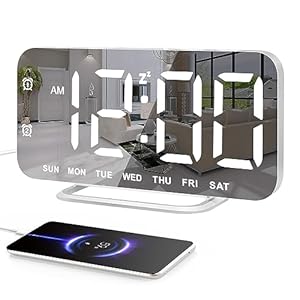
Joyful New Yr! 🍾
We want you, and all of the family members round you, all one of the best for 2024! 🥂
I can’t consider a greater technique to begin the brand new yr: Residence Assistant Core 2024.1! 🎉
This launch is pretty small, as anticipated; we’re simply popping out of the vacation
season. Nonetheless, it does include some good enhancements and
options to be enthusiastic about and a shocking whole of 13 new integrations!
My favourite: the automation editor modifications. It had fairly a bunch of consumer
interface tweaks. Most are centered on making it friendlier and simpler to make use of
for brand new and long-term customers, making it faster to search out the correct set off,
situation, or motion.
I vastly like this improved expertise, and I hope you do too!
Benefit from the launch!
../Frenck
Don’t overlook to join our release party live stream on YouTube
3 January 2024, at 12:00 PST / 21:00 CET!
Automation editor improvements
The automation editor got some love for this release, with many small
improvements to make it easier for both new and long-time users.
As there are many small improvements, let’s go over them individually.
PS: One quick note: all changes are UI changes, meaning that these changes
do not affect the underlying automation configuration. All your existing
automations will continue to work as they did before.
Improved empty automations dashboard
If you start with Home Assistant, visiting the automations dashboard would
result in an empty page. That is not very helpful if you see this for the
first time. So, we’ve improved that!
You are now greeted by the little automation robot that explains what an
automation is and references to the documentation that can help you get started.
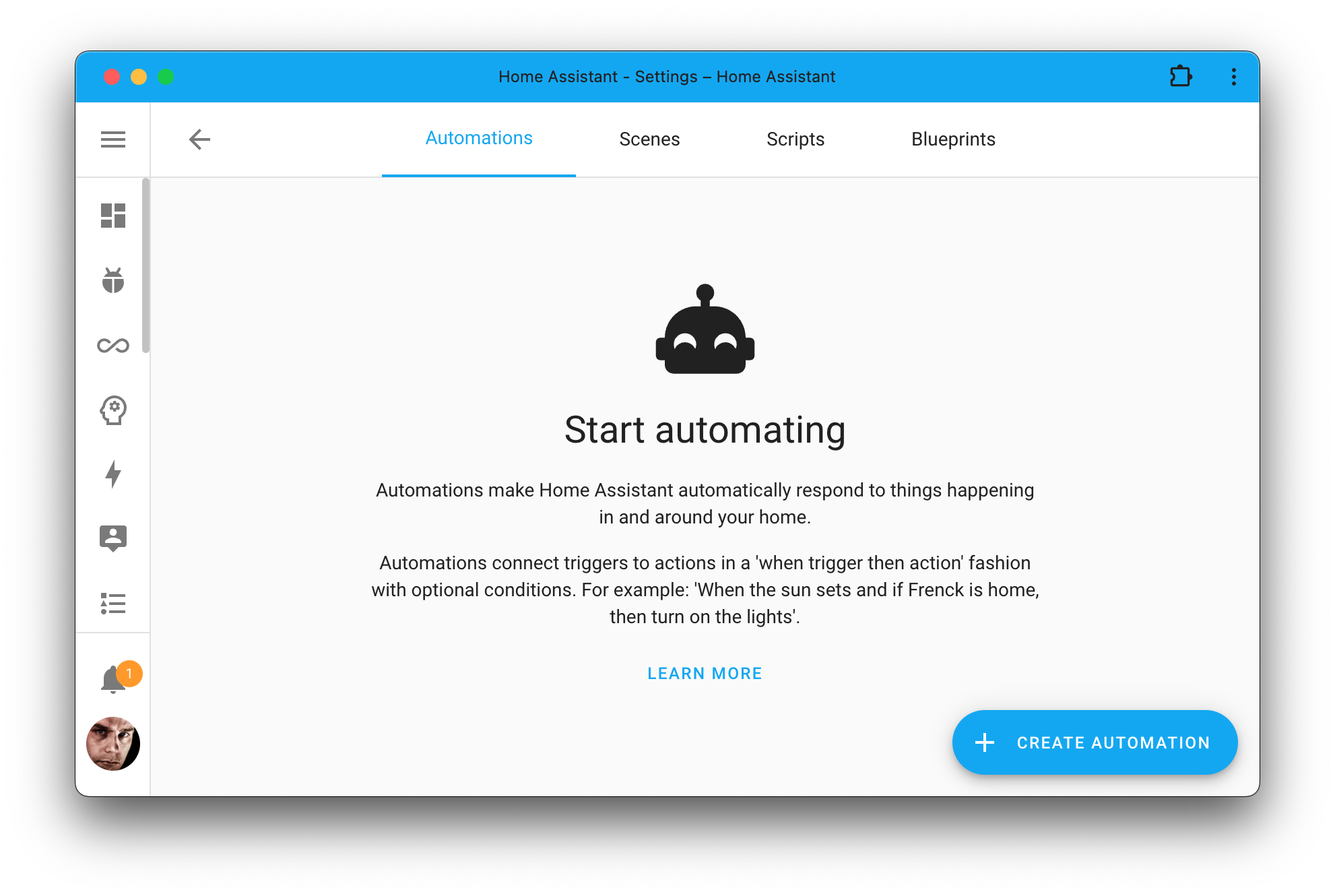
A small but effective improvement to help new users get started. We have also
applied this same improvement to the scripts and scenes dashboards.
Guidance when creating a new automation
When starting a new automation from scratch, you used to be greeted by some,
possibly, new terminology and almost a blank page with some buttons to
add triggers, conditions or actions. As a new user, this immediately imposes
a challenge: what do I need to do?
You guessed it: We have slightly improved that. We have changed the big headers
to be more descriptive and less technical. We have also added some help text to
explain each section, including examples of what they can be used for.
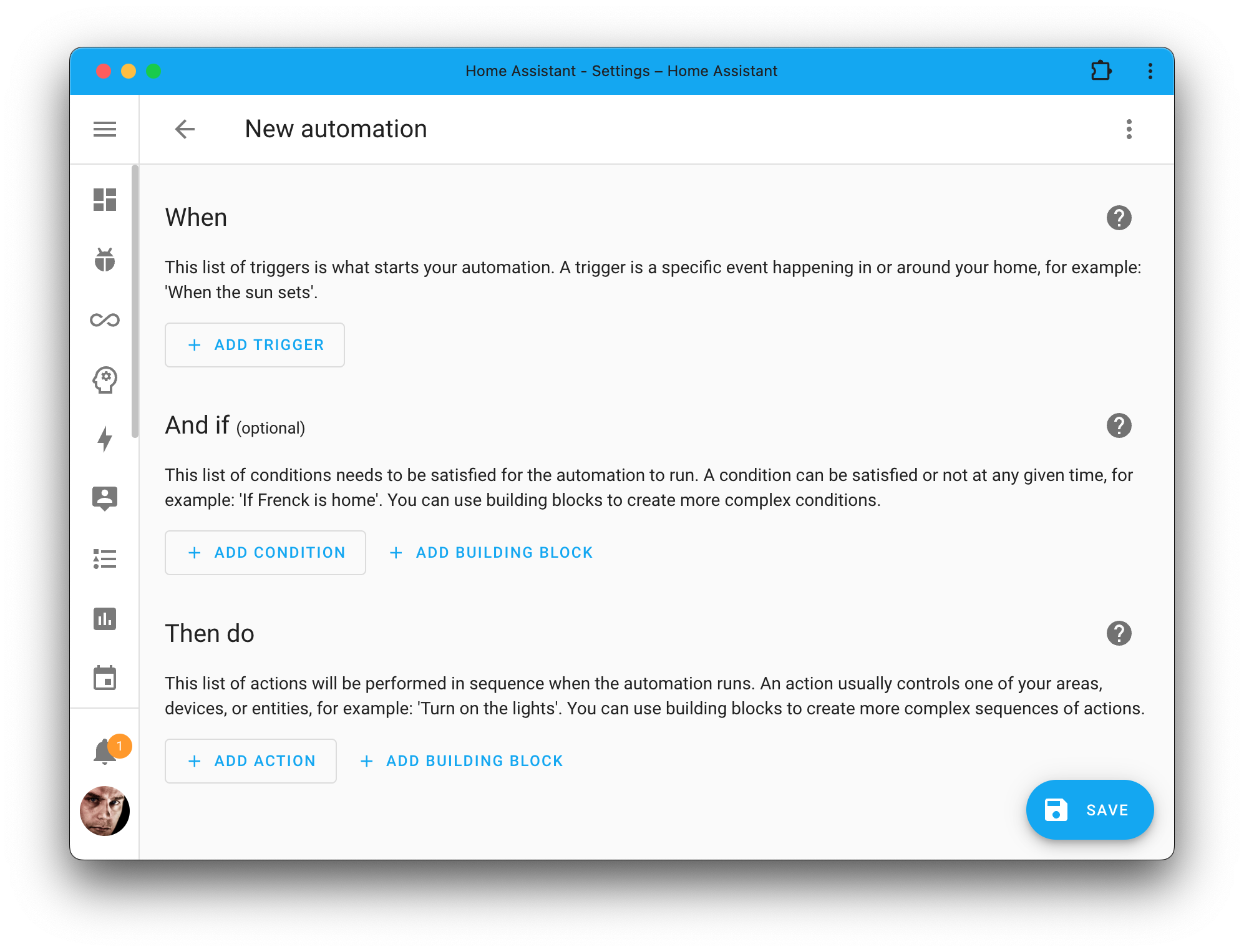
Don’t worry; we’ll hide the explanation once you add elements to the sections
to keep the overview of existing automations as clean as possible.
Building blocks
You might have noticed in the screenshots above the conditions and actions have
a new button next to them: + Add building block.
Selecting these new buttons allows you to add logical elements to your
automation or scripts, like And, Or, If-then, Choose, etc.
These used to be mixed in with the conditions and actions but now have their
own dedicated button. It makes it easier to find them and declutters the
list of conditions and actions.
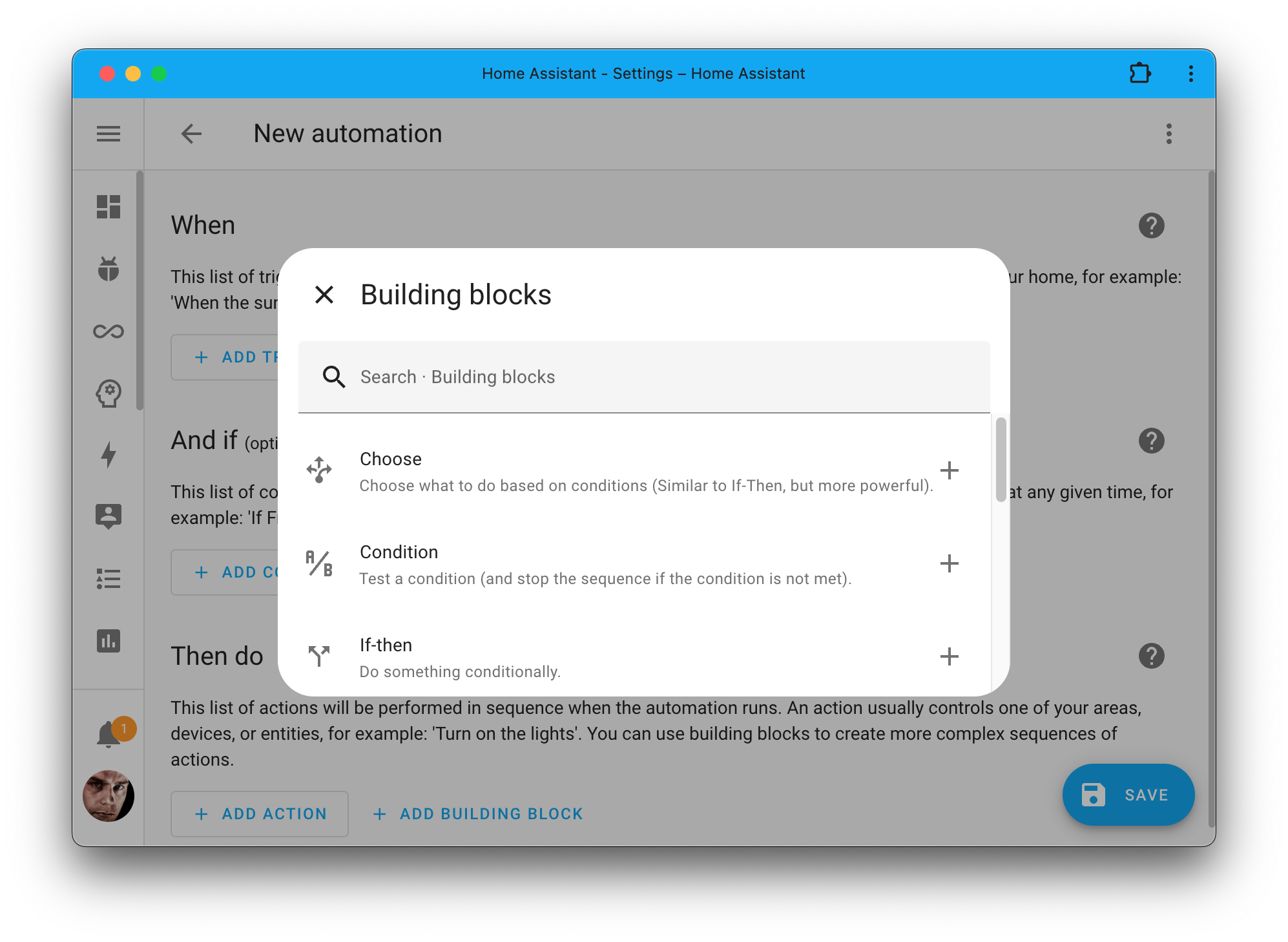
Notice how this now opens up a dialog? A dialog gives us more space to describe
what each building block does and room for a search box to find the one you need.
Improved trigger, condition & action buttons
The bigger change can be found in the buttons to add a trigger, conditions,
or actions to your automation. This change was not just aimed at new users
but also long-time users.
All these buttons are used to give a dropdown that allows you to select the
type of trigger, condition, or action you want to add. This dropdown has been
replaced by a new dialog similar to the one we just saw for the building blocks.
Like the building block, it describes what each trigger, condition,
or action does. These descriptions are important, as they help you understand
what they do.
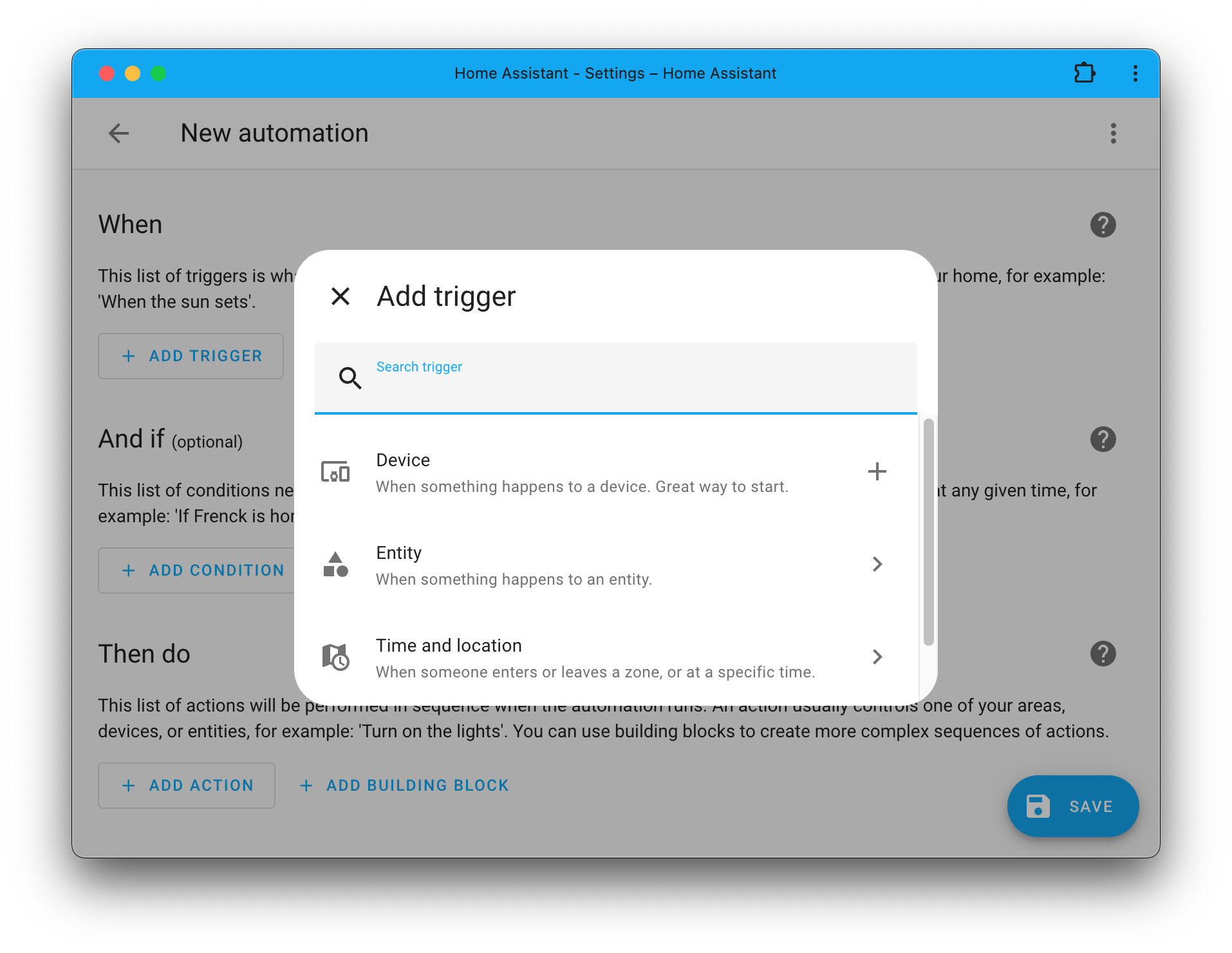
If you add an element, we will first show you the most used
triggers/conditions/actions by our community. We now have all others neatly
grouped. For actions, we took it a step further and unified them with
service calls.
Unified actions
If you have been using Home Assistant for a while, you are probably familiar
with the “service call”-action that you can add to your automation. But,
honestly, what is a “service call”? It is a bit of a technical term that is
especially confusing for newer users. You just want to turn on a light, right?
This release unifies those “service calls” with all other actions, meaning
there is no “service call” anymore; that layer has been refactored from the UI.
Instead, you add an action and select the action you want to take, for example,
turn on a light.
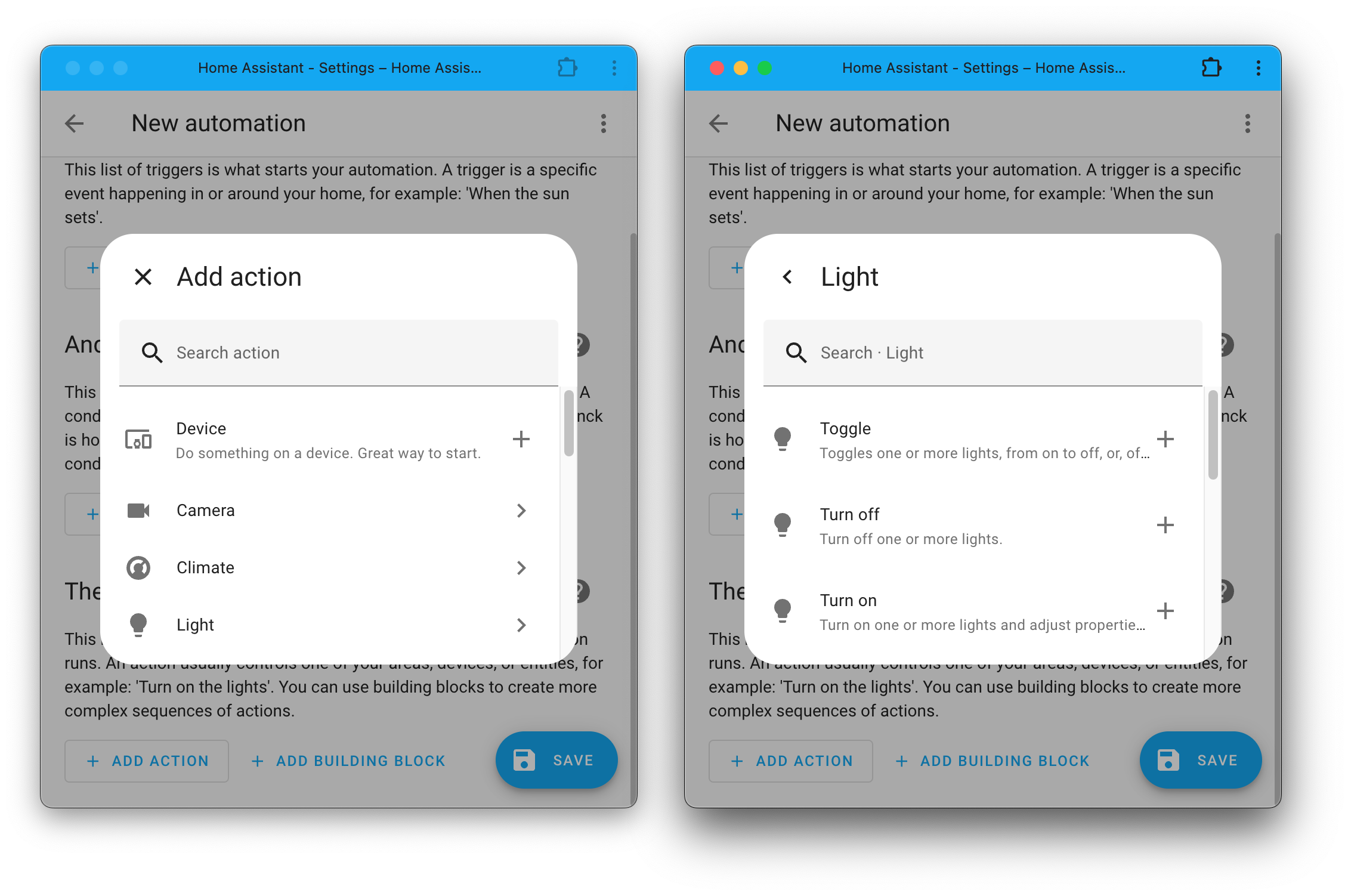
This means that if you add an action, you see all actions (including all
service calls), categorized, with description, and searchable! Being able
to search through all available actions is a huge improvement.
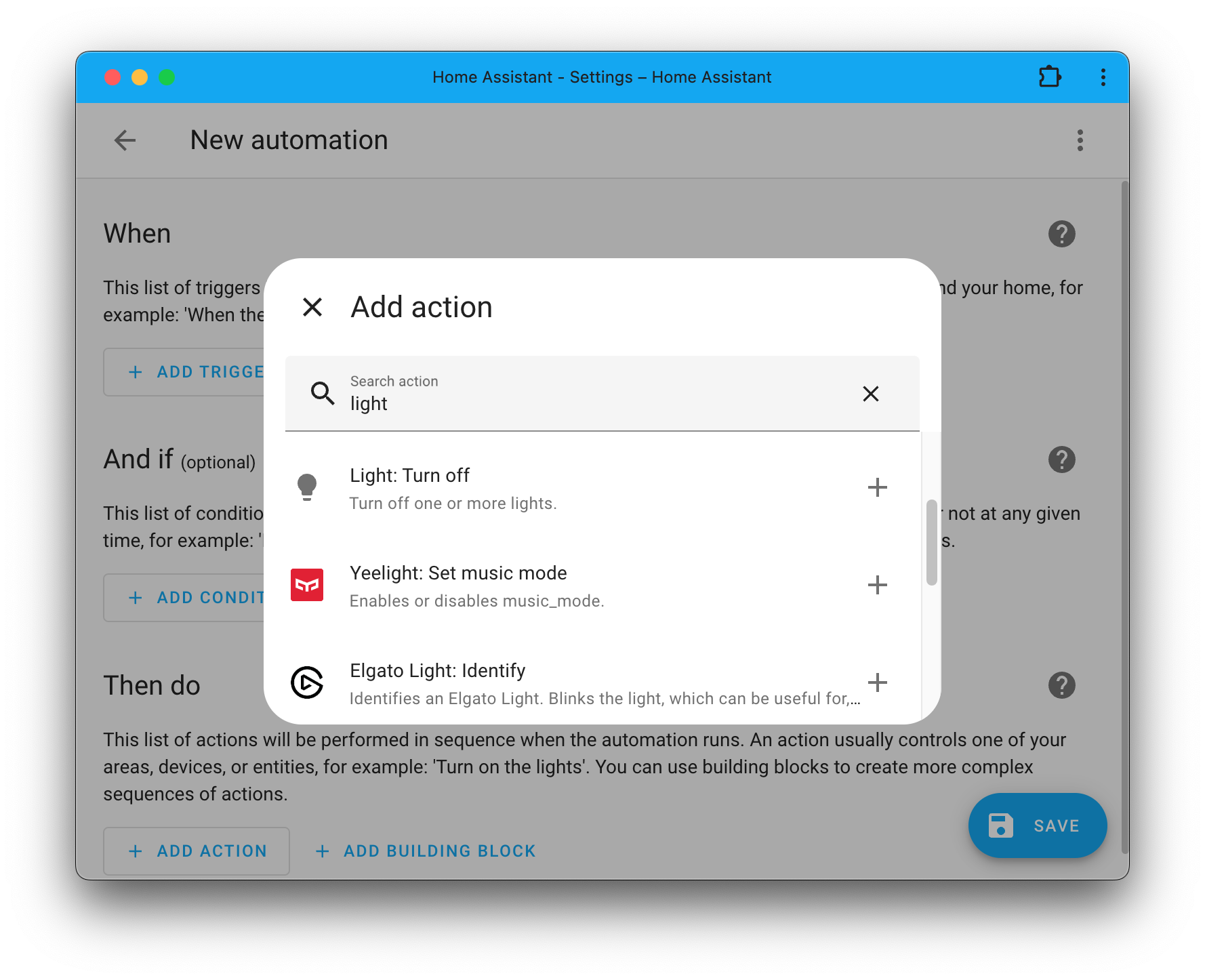
By default, just like with the triggers and conditions, we show you the most
used actions first and the actions for the entities you have on your system.
All others are neatly grouped by integration in the Other actions section.
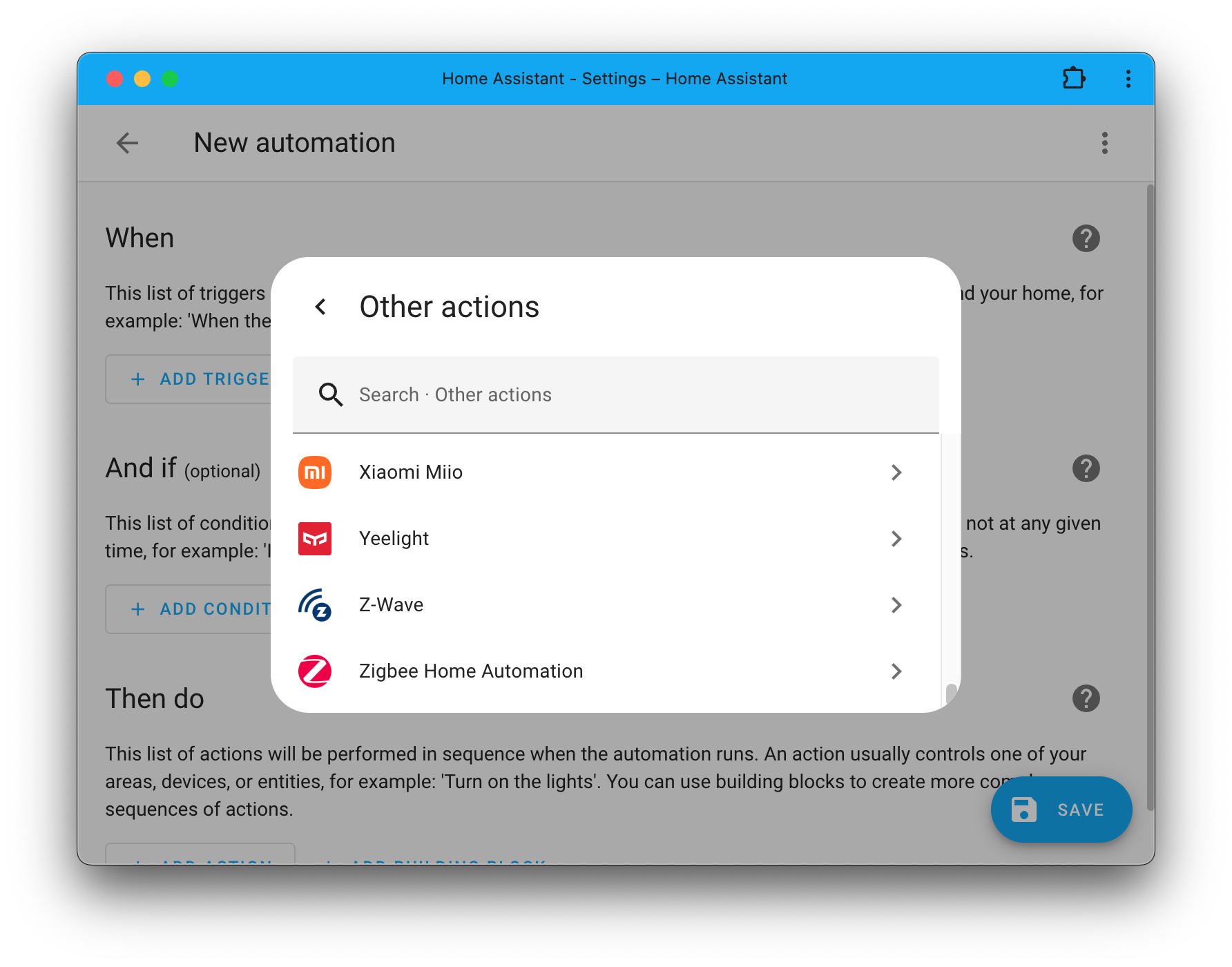
Description & due date support for to-do list items
The to-do list integration keeps getting better and better. This release adds
support for descriptions and due dates!
If the integration you are using supports it, you can now add descriptions to
each task on your list. It fully supports the Markdown markup to add links,
bold text, etc. If due dates (or due date + time) are supported, you can
set these.
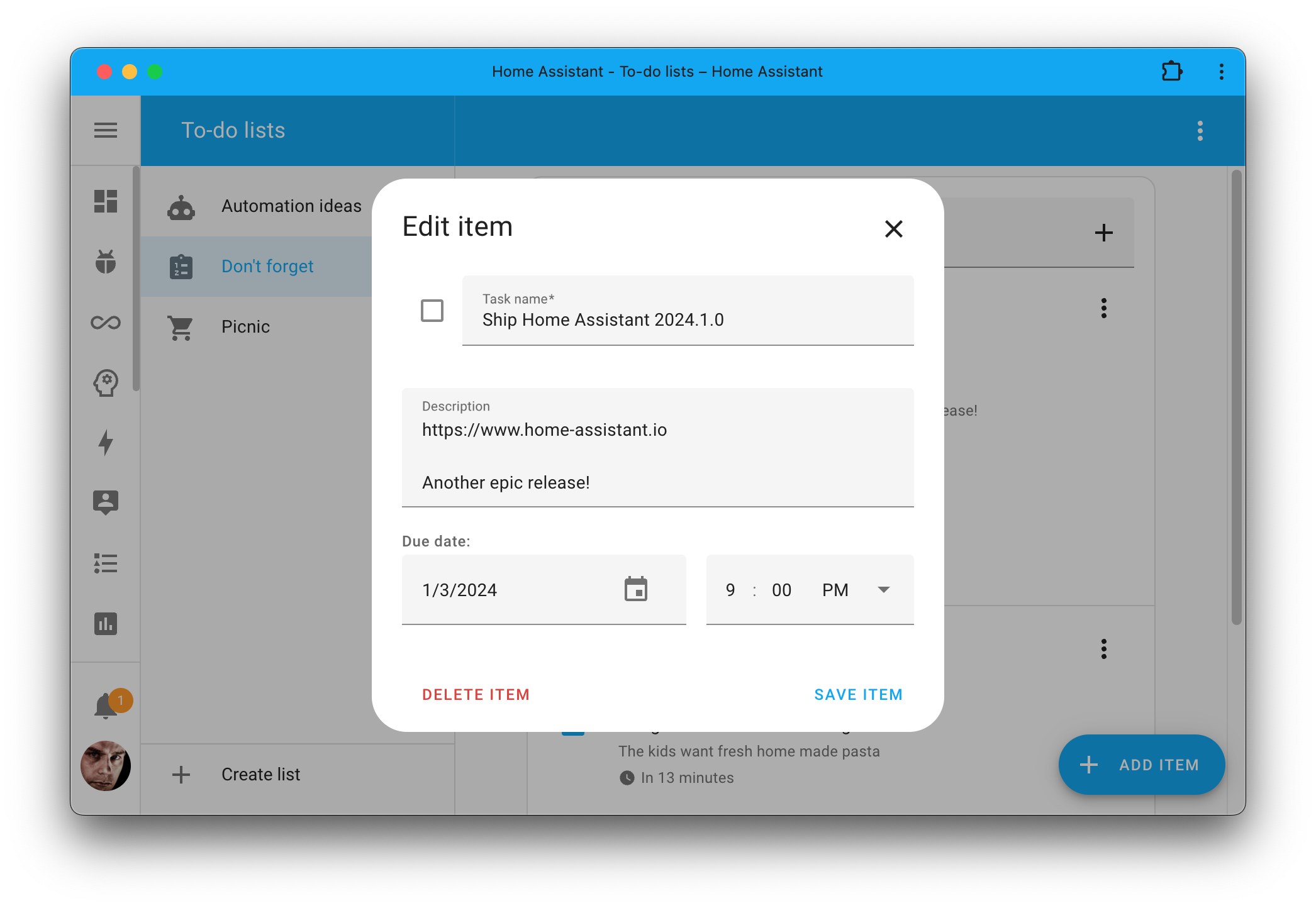
As shown in the screenshot above, there is a whole new dialog to adjust
your to-do item. But this is not the only change. The list itself has been
improved as well.
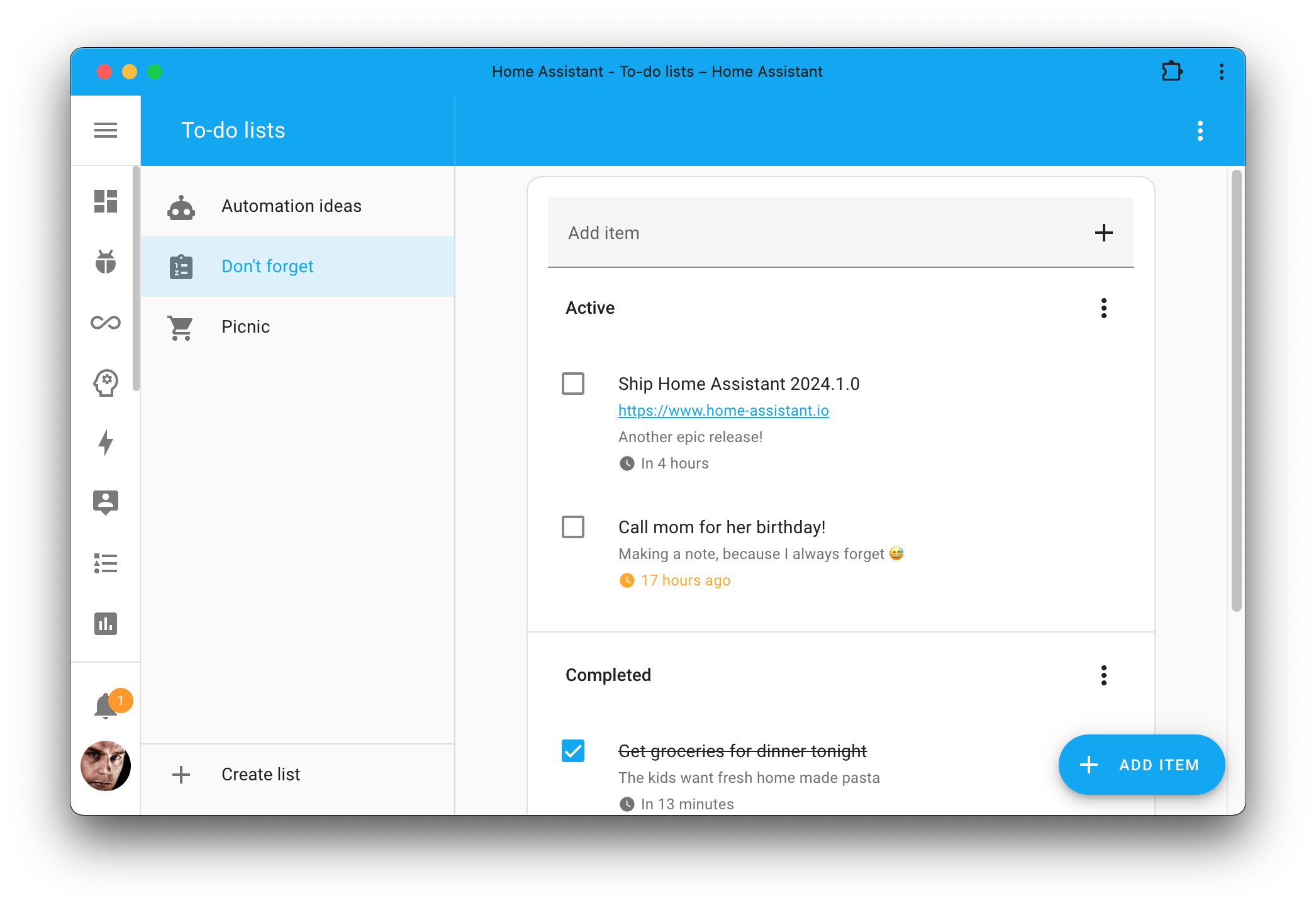
It is much cleaner, all big text boxes are gone, and each item is nicely
formatted, including an excerpt of the description and the due date. If the due
date is overdue, it will be highlighted.
New entity type: Valve
A brand new entity type has been added to Home Assistant: Valve!
Integrations can use this entity type to expose valves, such as a valve on
a radiator, pool, sprinkler system, and main house gas or water line.
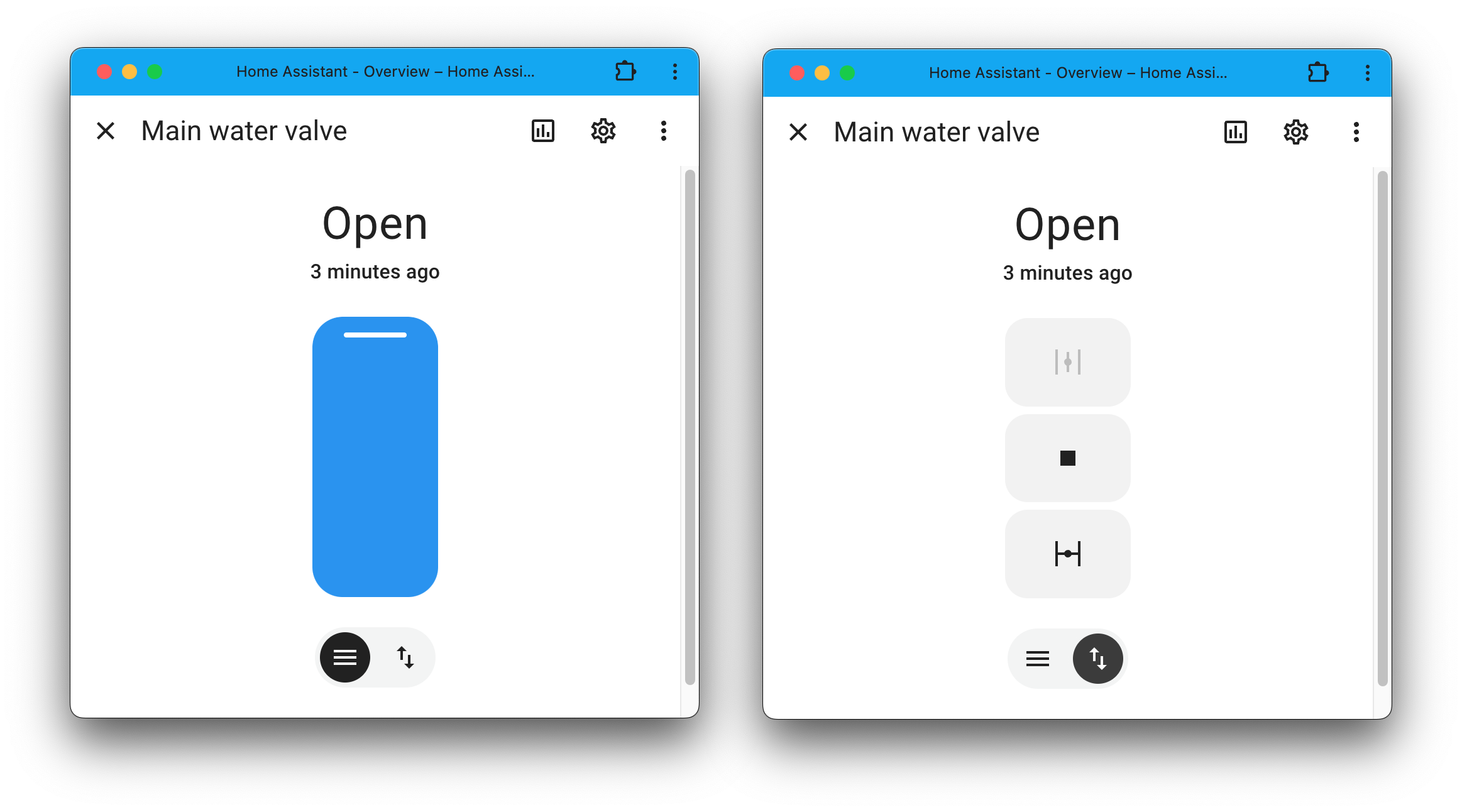
Currently, the Shelly integration helps it and now supplies a valve entity
for the Valve addon for Shelly Gasoline. Moreover, help for it has been
added to MQTT, and the valve entities additionally work with Amazon Alexa
and Google Assistant.
Tip: Do you’ve a swap entity that controls a valve? Now you can change the
entity sort to valve within the entity settings.
Swappable current/target on thermostat & humidifier cards
By popular demand, the thermostat and humidifier cards now support setting
current temperature/humidity as the primary information to show on the
card.
You can enable the show current temperature as primary information option
in the card, which will result in the target temperature being swapped with the
current temperature in the card.
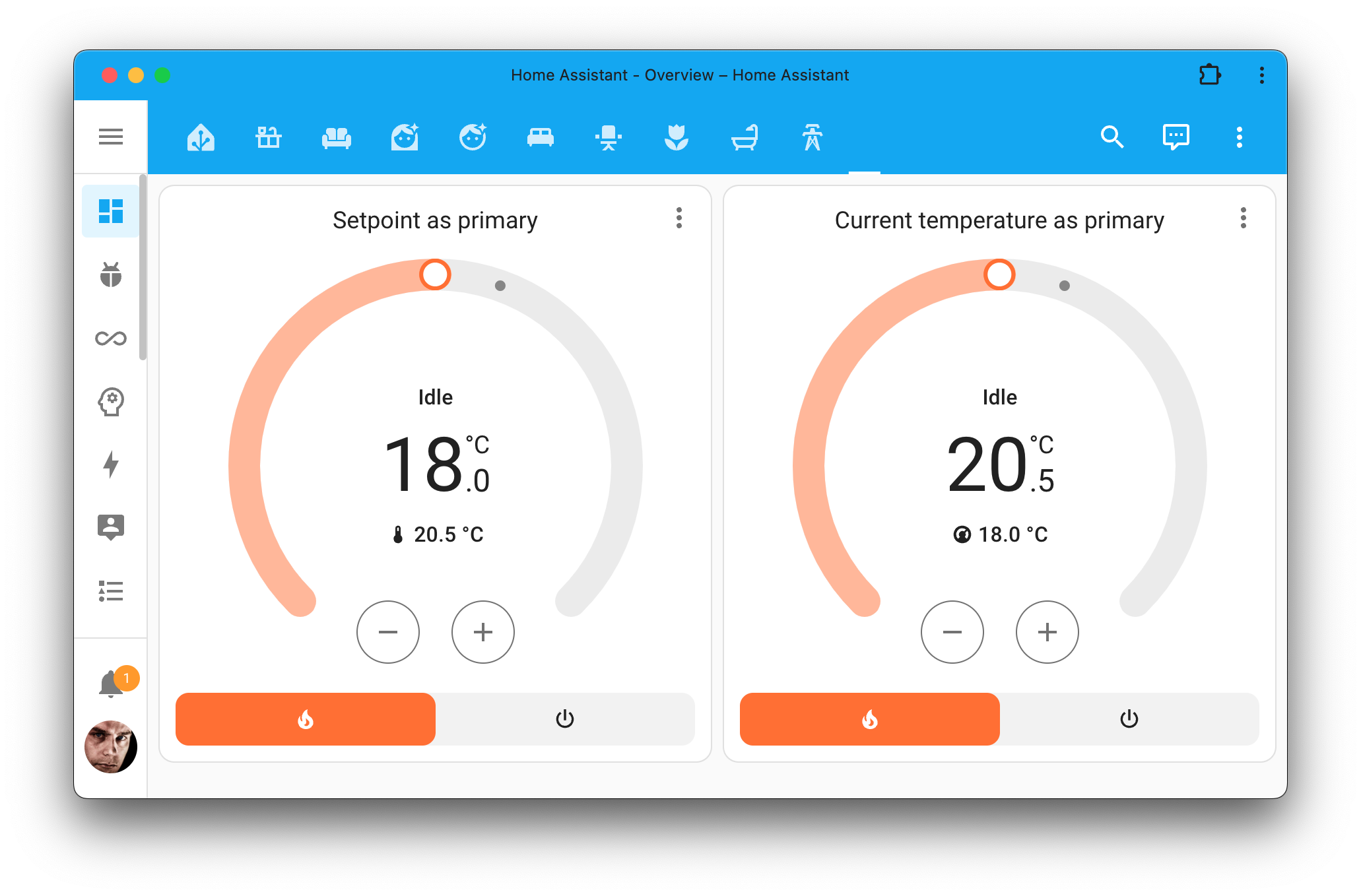
New card features
Last year, we saw many new features added to the cards, so let’s start
the new year with some more!
@Quentame added the local weather fan mode card function. This function may be
used with each the thermostat and the tile card:
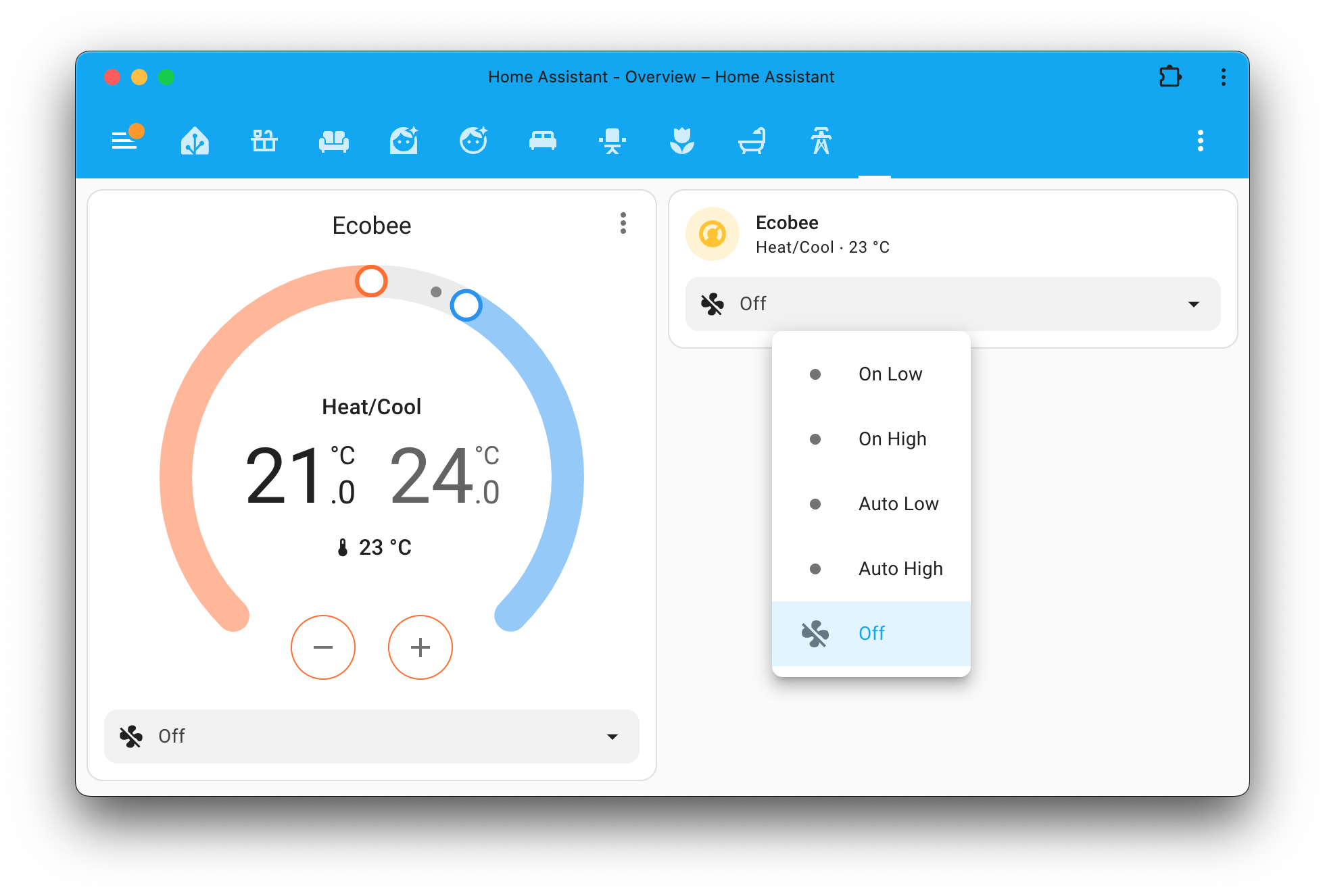
Additionally new is the replace actions card function. This addition by @piitaya permits
you so as to add buttons to a card to set off replace actions when pressed.
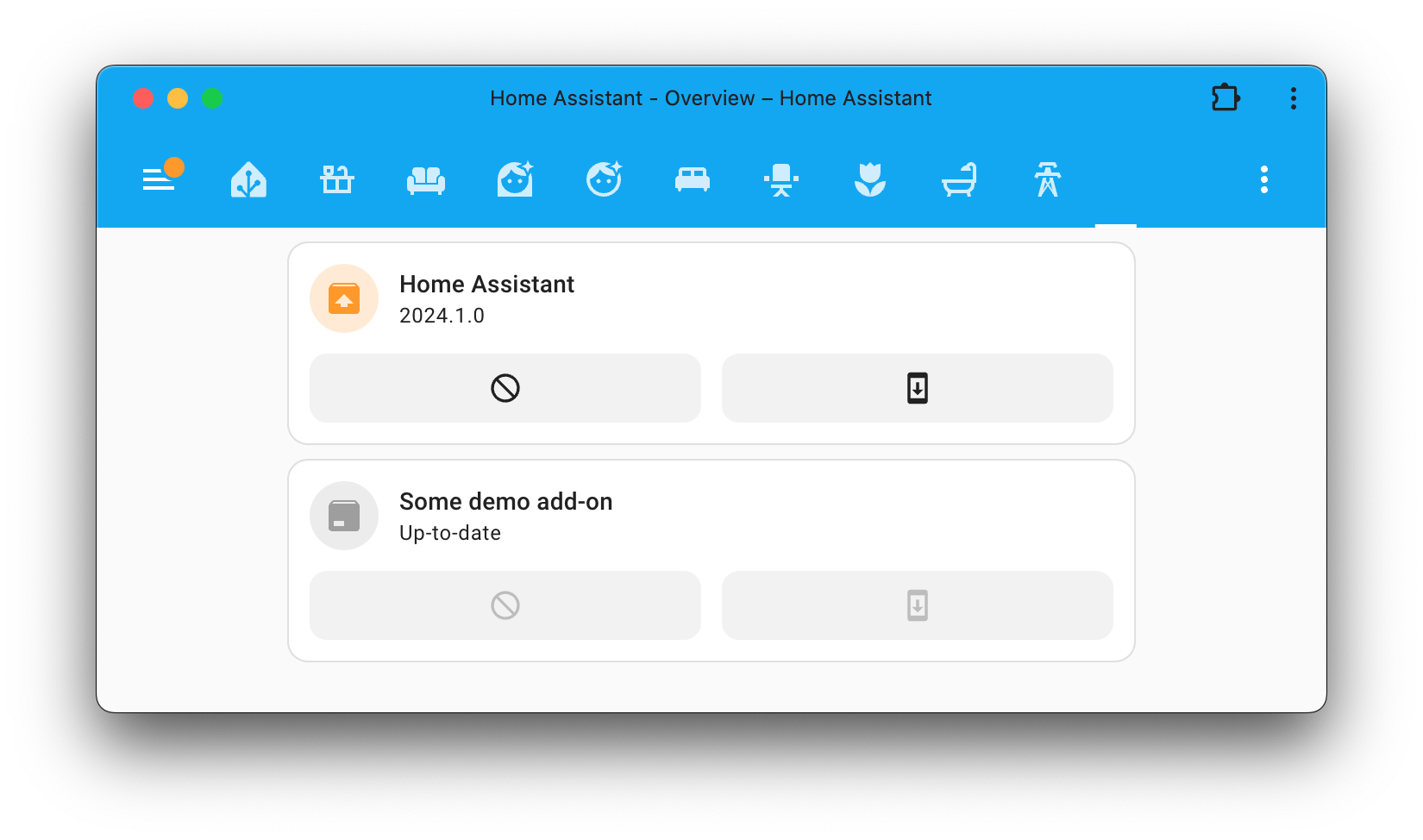
Other noteworthy changes
There are many more improvements in this release; here are some of the other
noteworthy changes this release:
- Two brand new template functions have been added this launch:
medianand
statistical_mode. Thanks, @TheFes! -
@bieniu added help for the model new Shelly third era units to
the Shelly integration. Good! - A protracted-time shutdown bug has been fastened: Now you can run automations triggered
when Residence Assistant shuts down. This might, for instance, be used to ship
your self a notification when that occurs. Thanks, @tetele! - Created your personal fan controller utilizing ESPHome? Now you can add preset modes
to it! Thanks, @mill1000! - The ping integration now has the choice to configure the variety of seconds
that should elapse earlier than contemplating a disconnected system “not at dwelling”.
Superior, @jpbede! - Searching for the ZAMG integration? It has been renamed to GeoSphere Austria.
Thanks, @killer0071234! - Obtained a type of Sonos amps? @jjlawren added help for the subwoofer
crossover setting to the Sonos integration. Good! -
@tkdrob added help for the brand new calendar entity to the Radarr integration.
So you may see the discharge schedules straight from Residence Assistant. Superior! - Now you can configure the minimal variety of samples the trend helper makes use of.
It lets you make it much less delicate when there’s not that a lot knowledge.
Thanks, @jpbede! - Obtained chilly toes in mattress? @kbickar to the rescue! He added help for
foot heaters to the SleepIQ integration. Good!
New integrations
We welcome the following new integrations in this release:
-
A. O. Smith, added by @bdr99
Combine and management your A. O. Smith water heater. -
Blue Current, added by @Floris272
Monitor your Blue Present EV charger cost level(s). -
DROP, added by @pfrazer
Handle your DROP Good Water System with Residence Assistant. -
Flexit Nordic (BACnet), added by @lellky
Management and monitor your Flexit Nordic collection air dealing with items. -
Holiday, added by @jrieger
Add vacation calendars to Residence Assistant for powering automations. -
Midea CCM15 AC Controller, added by @ocalvo
Use your AC related to a Midea CCM15 AC Controller. -
OSO Energy, added by @osohotwateriot
Use your OSO Power water heater with Residence Assistant. -
Sun WEG, added by @rokam
Gather and monitor vitality manufacturing knowledge out of your Solar WEG inverter. -
Tailwind, added by @frenck
Function your storage door openers related to a Tailwind good storage door controller. -
Tessie, added by @Bre77
Combine, monitor and management your Tesla automobile related to the Tessie platform. -
Refoss, added by @ashionky
Use your Refoss good units instantly with Residence Assistant. -
Valve, added by @cibernox
An entity sort for valves, which can be utilized by integrations to show valves. -
Vogel’s MotionMount, added by @RJPoelstra
Management the place of your Vogel’s MotionMount TV mount.
This launch additionally has a brand new digital integration. Digital integrations are stubs
which can be dealt with by different (present) integrations to assist with findability.
The next digital integrations have been added:
Integrations now available to set up from the UI
The following integrations are now available via the Home Assistant UI:
Release 2024.1.1 – January 5
Release 2024.1.2 – January 6
Release 2024.1.3 – January 12
Release 2024.1.4 – January 19
Release 2024.1.5 – January 20
Release 2024.1.6 – January 30
Need help? Join the community!
Home Assistant has a great community of users who are all more than willing
to help each other out. So, join us!
Our very active Discord chat server is a wonderful place to be
at, and don’t overlook to affix our wonderful forums.
Discovered a bug or subject? Please report it in our issue tracker,
to get it fastened! Or, test our help page for steering for extra
locations you may go.
Are you extra into e mail? Sign-up for our Building the Open Home Newsletter
to get the most recent information about options, issues taking place in our neighborhood and
different information about constructing an Open Residence; straight into your inbox.
Backward-incompatible changes
The service calls of Blink have been adjusted. This affects
blink.trigger_camera, blink.save_video and blink.save_recent_clips.
This change will require these service calls to be updated with a target for
the camera and by removing name from data of the blink service calls.
For example, service call before 2023.11:
service: blink.save_video
data:
name: Front door
filename: test.mp4
Service call after 2023.11 and before 2024.1:
service: blink.save_video
data:
device_id: 87dc3b85c18ee84f8c322a95e8230eb2
name: Front door
filename: test.mp4
New service call:
service: blink.save_video
target:
entity_id:
- camera.front_door
data:
filename: test.mp4
The blink.send_pin service now uses an integration/configuration entry selector:
Example service call before 2023.11:
service: blink.send_pin
data:
pin: "1234"
Service call after 2023.11 and before 2024.1:
service: blink.send_pin
data:
pin: "1234"
device_id: 87dc3b85c18ee84f8c322a95e8230eb2
New service call:
service: blink.send_pin
data:
config_entry_id: a1bee602deade2b09bc522749bbce48e
pin: "1234"
The blink.blink_update service is deprecated and will be removed in 2024.7.0.
Use the homeassistant.update_entity service instead.
(@mkmer – #105413) (documentation)
The occasion key within the (undocumented) set off knowledge for the homeassistant set off
platform is now the string shutdown for a homeassistant set off configured
to fireside on shutdown as a substitute of an Occasion object.
(@tetele – #91165) (documentation)
- The printer state now comprises a number of new statuses, most significantly
“consideration”, which at all times wants your intervention. - Firmware 4.7.0 is now the minimal model for Prusa XL and MK4.
- Firmware 5.1.0 is now the minimal model for Prusa Mini since 4.7.x and 5.0.x
aren’t out there for the Mini.
(@Skaronator – #103396) (documentation)
The Reolink Infrared lights in night time mode entity has been migrated from
the mild to the swap area.
This implies the entity ID additionally modified, and automations and dashboards might have
to be adjusted to make use of the brand new entity ID.
If you wish to return to the sunshine area, use the
switch_as_x “Show as” option
on the brand new Infrared lights in night time mode swap entity and choose mild.
The minimal supported firmware model for era 1 units is 1.11.0 (2021-07-15).
The minimal supported firmware model for era 2 units is 1.0.0 (2023-08-03).
You have to replace your units to the firmware variations listed or newer.
(@bieniu – #105384) (documentation)
If you’re a customized integration developer and need to find out about breaking
modifications and new options out there to your integration: You should definitely comply with our
developer blog. The next are essentially the most notable for this launch:
All changes
Of course, there is a lot more in this release. You can find a list of
all changes made here: Full changelog for Home Assistant Core 2024.1
Trending Merchandise



